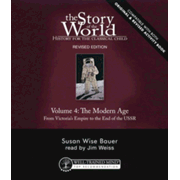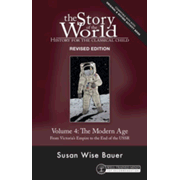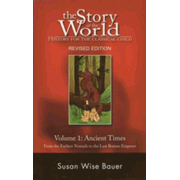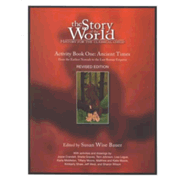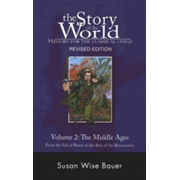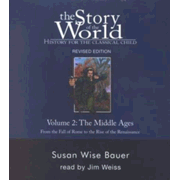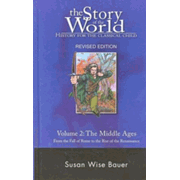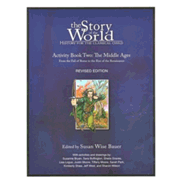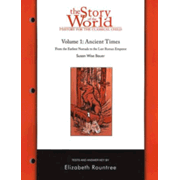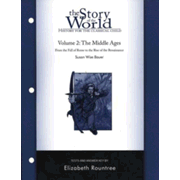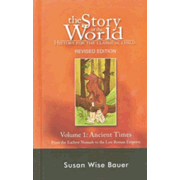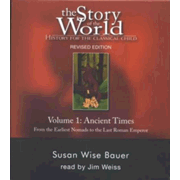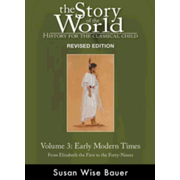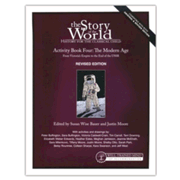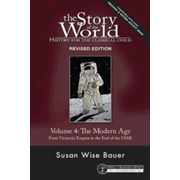The Story of the World (SOTW) by Susan Wise Bauer presents world history through storytelling in this four-volume series. Bauer has selected key characters and events to highlight in each volume rather than trying to provide comprehensive coverage. There’s much to be said for this approach in contrast to history texts that cover more information but with little or no depth on any of the topics.
While these books are written at increasing levels of difficulty, they might be read aloud to younger children and read independently by older. The SOTW books are available in your choice of hardcover, paperback (lay-flat binding), PDF, Kindle, and audiobook (either MP3 or CDs). You might want to use the audiobook version of one of the books along with a physical book so that students can listen while they read or just listen on their own. (You still need a version that you can read and view.)
Many will recognize Bauer as one of the authors of The Well-Trained Mind (wwnorton.com)—an exceptionally useful book on providing a classical education. This history series is intended to be used within the context of just such an education, even though it also works with other educational approaches.
Each of the four books features quite a few black-and-white illustrations and a good number of maps. The books are intended to either be read aloud or used for independent reading by older students, but the illustrations and maps should be viewed by all students.
At the back of each book are a pronunciation guide, a chronology, and an index. The chronology might be especially helpful if you choose to create a timeline. You could have students make entries on the timeline for items on the chronology.
Activity Books
The SOTW books are intended to be used as spine books around which you build a complete study. To help you do just that, the author has also created activity books for each volume that are available as either softcover books or PDFs. These activity books serve as curriculum guides, providing parents with detailed information for creating multi-sensory lessons that can be used across a wide spread of grade levels. For each lesson, there is a compilation of questions, narration exercises, reading lists (for both history and literature), map work, coloring pages, and activities to accompany each section of the text.
The activity guides have cross-references for each chapter to The Kingfisher Illustrated History of the World, The Kingfisher History Encyclopedia, The Usborne Book of World History, and The Usborne Encyclopedia of World History. You would do well to purchase at least one of these additional basic resources. These books supply the colorful illustrations lacking in the core history books as well as more complete historical information on some topics. The activity guides also have lists of other recommended books on specific topics or about particular people that you might want to use.
The questions in the activity guides, called Review Questions, are to be used with students after you have read a chapter or they have read it on their own. Younger students can answer orally. For older students, you might want to purchase the Review Questions Worksheets PDF for each book. It has the same Review Questions as those in the activity guides but in a worksheet format so that students can write out their answers rather than responding orally.
The Review Questions are followed by a narration exercise. The instructions in the activity guides tell how to have children narrate (summarize orally) the main ideas from that chapter in two to five sentences. For younger children, you can write down the oral narration for them. Older students should write out their own narration. Sample narrations are provided in the activity guide but children should be allowed to focus their attention on other aspects of the chapter's story than those in the sample narrations.
Reproducible student pages in SOTW activity books are segregated from lesson plans into their own section, which makes copying easier. You are given permission to copy these pages for only your family. However, the publisher sells the reproducible pages as either a packet of looseleaf pages or a PDF, and these might be worth purchasing.
You will find some very unusual project ideas in the activity books such as mummifying a chicken and making Greek tattoos with pure henna. Reproducible blackline masters in the activity books are used for all sorts of things—mapwork, board games, paper dolls, making a lighthouse, and more.
Another useful feature of the activity books is Review Cards—reproducible pages with illustrations and blocks of information on each card. They are to be copied onto card stock and cut out. (I would suggest enlarging each page slightly before copying.) These cards can be used as flashcards to review key ideas.
While the activity books have coloring pages, you might want the optional Coloring the Story of the World book. It has 60 coloring pages. Thirty of them feature images from the activity books that have been improved and sharpened, and the other 30 are newly created by Jeff West, the artist who has been creating images for the series more many years. The back of each coloring page describes the image, its historical context, and the relevant SOTW volume and chapter.
Tests
For younger students, oral review is sufficient. But to assess comprehension and retention for students in grades four and up, a book of tests (with answer keys) is available for each volume. The test books have a test for each chapter, and they include various types of questions: multiple-choice, matching, fill in the blank, and true-false. Tests for volumes two and above include some questions that require answers written in complete sentences, and the tests for the fourth volume add essay questions.
Volume 1: Ancient Times
Volume 1: Ancient Times addresses the time period from the earliest nomads (given a date of about 6000 B.C.) up through the last emperor of ancient Rome. While the target audience is grades one through four, this book’s 338 pages provide a lot of material in comparison to most world history texts for these grades. Nevertheless, coverage is not comprehensive because chapters are devoted to lengthy stories about key characters or events rather than tidbits about everything. On the other hand, the book does span civilizations from around the world, including those in India, China, and West Africa in addition to the usual cast for studies of western civilization.
The presentation is not overtly Christian, although it recognizes and includes coverage about Christianity. Stories of gods and goddesses from other cultures are retold without value judgments as to their validity. However, the author’s own Christianity is still evident in the heavy weighting of biblical stories—lengthy accounts about Abraham, Joseph, Moses, and the beginnings of Christianity, as well as the birth, death, and resurrection of Jesus.
The entire activity book for the first volume is 320 pages in length, and the reproducible pages account for 127 of those pages.
An expanded and updated edition of this volume is available as of October 2025 in audio and digital versions, with the print book due in 2026. The new edition has two new chapters on East Asian history, more text and maps in other sections, and ten additional biographies.
Volume 2: The Middle Ages
Volume 2: The Middle Ages, which covers from the Fall of Rome to the Renaissance, is very much like the first volume but is written for an audience in grades two through five. In her delightful style, Bauer covers a huge amount of territory with selective highlights that actually provide good introductory coverage. She hits touchy territory when it comes to the Reformation although she tries to balance her presentation better than do most authors. However, I suspect some Catholics might want to skip or “edit” her chapter on Martin Luther.
The activity book for Volume 2 is even larger than the activity book for the first volume with 464 pages.
Volume 3: Early Modern Times
Volume 3: Early Modern Times covers the era of England's Queen Elizabeth I through the California Gold Rush and the forty-niners. It continues in the same fashion as the previous volumes, targeting grades three through six. However, it seems a little scattered because it ambitiously tries to cover a huge swath of worldwide history in about 500 pages. It seems even more selective and limited in topics covered than previous volumes, although featured topics each get enough attention to present an engaging story. The activity book offers suggestions for expanding on any topics you wish with supplemental books and activities.
Volume 4: The Modern Age
Volume 4: The Modern Age continues from 1850 up through the end of the twentieth century. Meant for grades four through eight, this volume is more like a history text than the other books. It uses storytelling within the context of relating historical events rather than telling selected stories, making it more comprehensive in coverage than earlier books. In my opinion, this is one of the best options for world history for upper elementary through junior high levels. One issue that might give some parents pause is one of omission. Religion and its influence are seldom mentioned. Nevertheless, this is a very engaging history resource that should work for most families.
The activity book for Volume 4 teaches students how to outline what they read in the text. Halfway through the book, students begin to write from the outlines, recalling and writing details to expand their outline into a composition. This activity book also adds The Usborne History of The Twentieth Century as another reference resource.
Summary
The four The Story of the World core volumes and the expanded courses created by using the activity books are valuable contributions that fill a need for Christian-friendly, classically-oriented history study.
The publisher’s website has samples you can view as well as information about ancillary products, such as coloring books for younger students.











